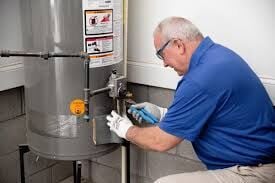
A water heater is a very important device that gives hot water for many activities in the home, like taking showers or baths as well as washing dishes and doing laundry. Knowing about the kind and size of your water heater is important. Tanks should be emptied once every year so they don't get filled with dirt; this ensures better transfer of heat and makes the appliance last longer. A plumber's regular check can catch problems before they become big, avoiding expensive fixes and keeping the water temperature stable.
Checking and Adjusting the Temperature Settings
Observing and modifying the temperature adjustments of your water heater is beneficial for energy efficiency and safety. You should set the thermostat to a suggested temperature of 120 degrees Fahrenheit (about 49 Celsius) in order to avoid scalding and lessen energy use. Insulate hot water tubes as well as the tank with good insulation materials for minimizing heat loss which will enhance efficiency overall. These small alterations not just save electricity but they also guarantee a consistent flow of hot water for the house, making it more convenient and comfortable.
Inspecting for Leaks and Drips
It is important to check your water heater regularly for leaks or drips. This will help prevent water damage and keep the system working well. Look around the tank, pressure relief valve, and pipes to see if there are any signs of moisture, corrosion or rust. Taking care of small leaks right away by tightening fittings or changing parts that are old can stop possible water damage from happening and save you money on big repairs later on. If you see leaks that keep coming back or a lot of corrosion, it's good to ask a plumber to check and tell you what repairs or parts need to be changed so that the system keeps working and stays safe.
Flushing the Tank Regularly
Every year, it is good to flush your water heater tank. This process helps eliminate sediment and mineral accumulation that occurs with time. The buildup of sediment can decrease the efficiency of heating, cause more energy use and also result in early wearing out for heating elements or valves. To do a tank flush, stop the power supply to your water heater and attach a hose onto its drain valve located at the bottom of the tank. Turn on the valve and let out a few gallons of water until it becomes clear, showing that sediment has been removed. This helps in making the water heater work better and last longer which reduces chances for sudden breakdowns.
Inspecting and Testing the Pressure Relief Valve
The pressure relief valve is a safety part that stops too much pressure from forming inside the water heater tank. Regularly check and test this valve to make sure it works right in emergencies like overheating or sudden increase in pressure. For testing the valve, you need to gently lift its lever to let out some water and check if there is a good flow of water. If the valve doesn't work right or water keeps dripping even after trying to tighten it, call a plumber to look at it and change if needed. Checking that the pressure relief valve is in good condition helps keep the system safe and stops any possible dangers.
Maintaining Adequate Ventilation

Ventilation of your water heater is necessary for it to work well and be safe. Make sure that the place near the water heater has good air movement, with no mess or dirt which could stop airflow. Ventilation helps in stopping too much heat, keeps energy use down and makes heating parts last longer. Check vents and air intake openings frequently, making sure they do not have any obstructions, dust or debris that could affect the airflow. Talk with a plumber or HVAC specialist to guarantee good ventilation and safe operation of your water heater.
To keep your water heater working well and efficiently, you need to look at it often, take care of it beforehand, and fix any problems on time. You should understand how your water heater system works, control the temperature settings, look for leaks regularly and flush the tank every year. These actions are important for increasing energy efficiency and prolonging the life of this appliance. Testing the pressure relief valve and maintaining enough ventilation area around your water heater also add to safety and reliable function. If homeowners follow these maintenance tips and seek professional help from a plumber when required, they can expect steady hot water supply, decrease in energy expenses, and avoidance of unforeseen malfunctions. This will guarantee the long-lasting dependability and effectiveness of their water heater system.





(0) comments
Welcome to the discussion.
Log In
Keep it Clean. Please avoid obscene, vulgar, lewd, racist or sexually-oriented language.
PLEASE TURN OFF YOUR CAPS LOCK.
Don't Threaten. Threats of harming another person will not be tolerated.
Be Truthful. Don't knowingly lie about anyone or anything.
Be Nice. No racism, sexism or any sort of -ism that is degrading to another person.
Be Proactive. Use the 'Report' link on each comment to let us know of abusive posts.
Share with Us. We'd love to hear eyewitness accounts, the history behind an article.